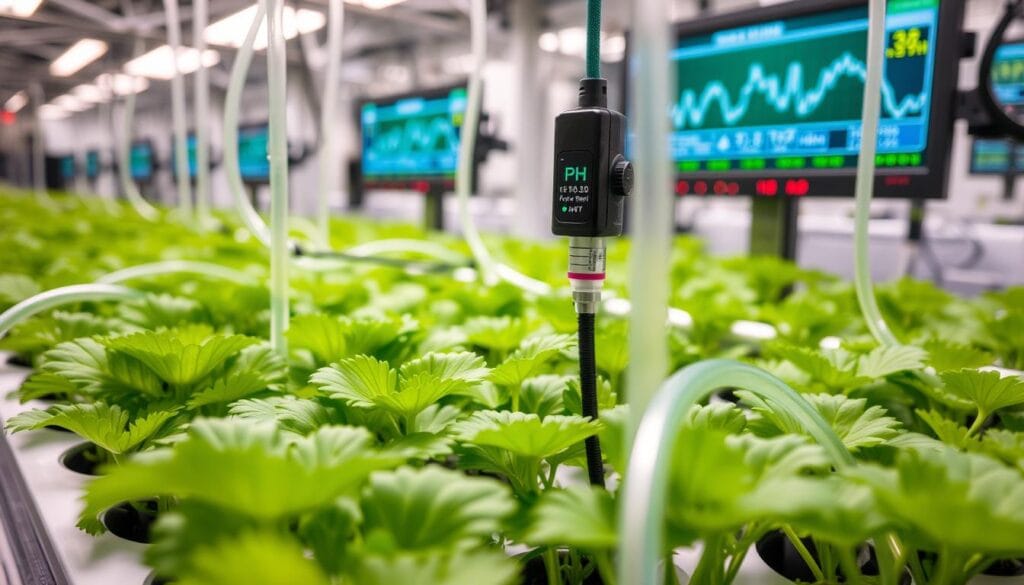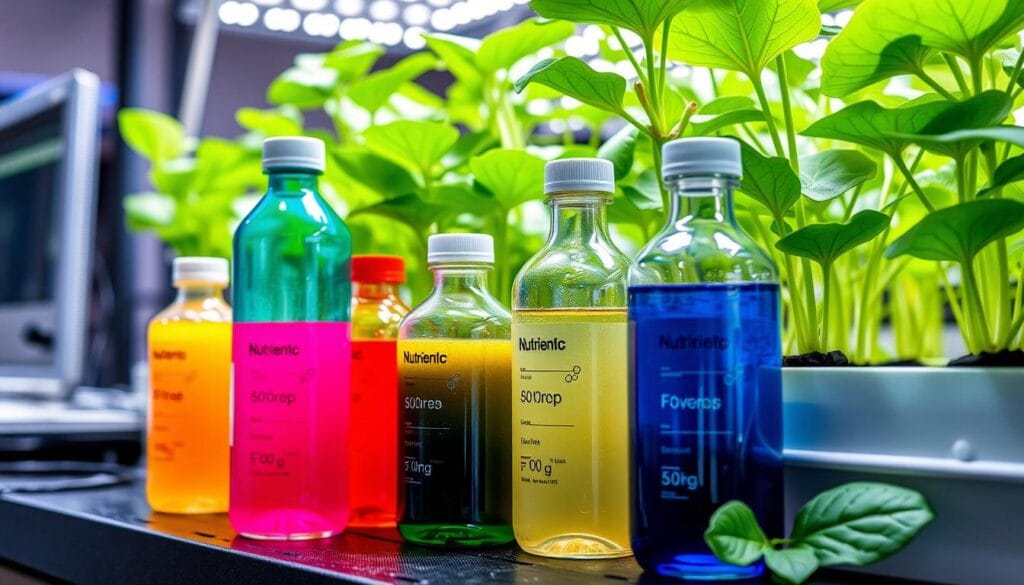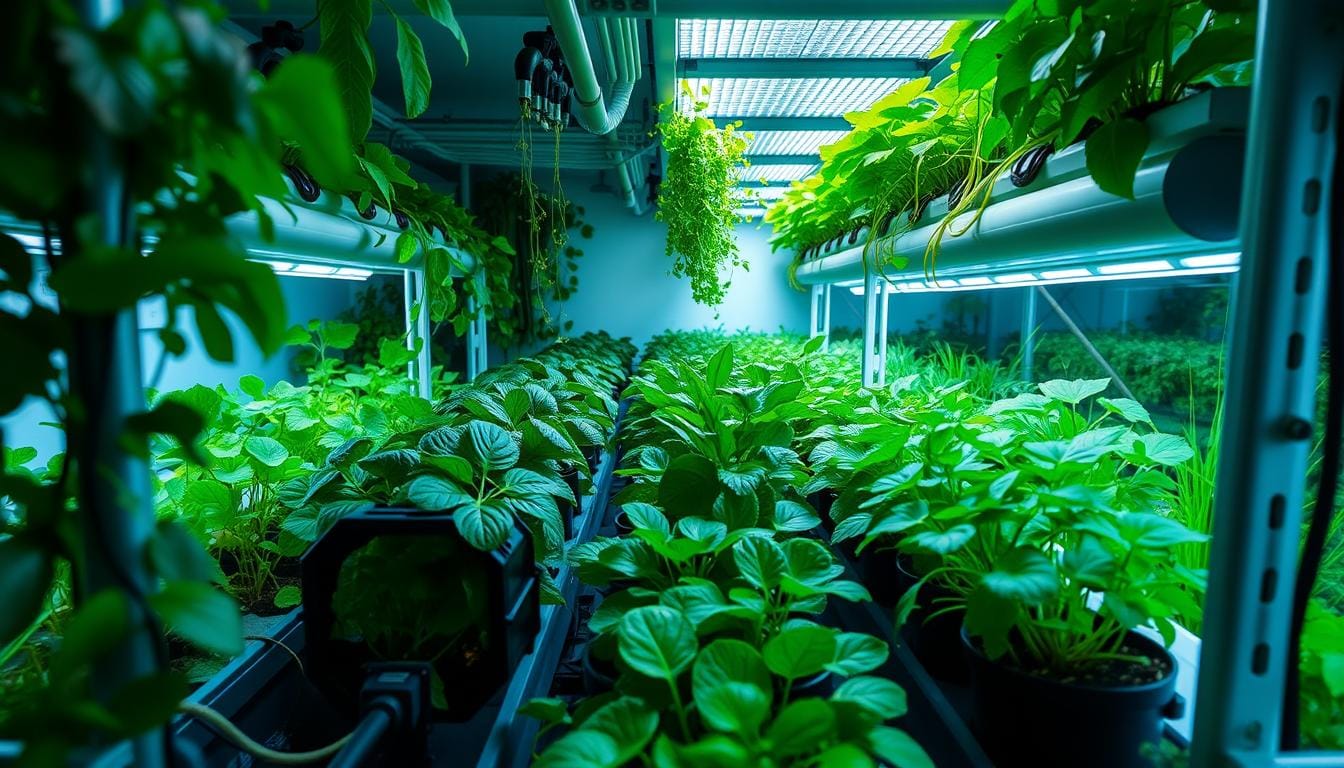Hydroponic System Automation can make starting your hydroponic gardening journey less overwhelming. With the right help, you can master automated hydroponic systems and transform your indoor space into a lush, productive garden
Imagine a garden that takes care of itself, so you don’t have to worry about watering or checking nutrient levels. Automated hydroponic systems make this dream come true. They give you control over your indoor garden’s every detail.
Key Takeaways
- Automated hydroponic systems integrate hardware and software to manage your indoor garden remotely
- These systems provide real-time insights into plant needs, ensuring optimal growth conditions
- The Kratky method is a beginner-friendly passive hydroponics technique that eliminates the need for air pumps
- Smart irrigation technologies can help you precisely monitor and control water consumption for your plants
- Automated systems can streamline tasks like nutrient management and environmental control for maximum efficiency
Understanding Hydroponic System Basics
Hydroponics offers an innovative method for growing plants without the use of soil. It uses water full of nutrients. This method is popular for its benefits, appealing to both big growers and hobbyists.
What is Hydroponics?
Hydroponics grows plants in water, not soil. It lets growers control the plant’s environment closely. This means plants grow better and use less water, making it good for water management.
Benefits of Automated Hydroponic Systems
- Efficient water usage: Hydroponics can save up to 90% of water compared to traditional gardening.
- Faster plant growth: Plants grow quicker and produce more in hydroponics because of direct nutrient delivery.
- Reduced pest pressure: The controlled environment of hydroponics means less need for pesticides, leading to healthier plants.
- Year-round growing capabilities: Hydroponic gardens can be indoors, perfect for hydroponic farm automation and city living.
Key Components of Modern Hydroponic Setups
A hydroponic system has key parts like grow lights and nutrient solutions. It also has pH and EC meters, air pumps, and dosing pumps. These work together to give plants the right nutrients, oxygen, and water.
The Kratky method is a simple way to start. It involves plants floating in a nutrient solution. This method doesn’t need extra equipment.
Learning about hydroponics and automated systems opens up new possibilities. It leads to more efficient and sustainable gardening.
Smart Irrigation for Hydroponics
Smart irrigation technology is a big leap for hydroponic growers. It uses sensors, IoT, and algorithms to save water and nutrients. This tech automates watering, giving plants just what they need for better growth.
The LetPot Automatic Watering System is a top choice, priced at $56.49. It’s a $13.50 discount from its regular price of $69.99. It has adjustable drippers for up to 20 plants and a 12G/H water pump for precise watering.
These systems work well with hydroponics, using IoT-enabled irrigation and sensors. They monitor temperature, humidity, and nutrients. This lets them adjust water and nutrient delivery for the best plant growth.
“Smart irrigation systems can adapt their watering schedules based on historical evapotranspiration data, ensuring optimal water usage.”
Smart irrigation brings big benefits to hydroponics. It saves time and cuts water waste by up to 50%. It also gives you data to make better choices, leading to healthier plants and more yields.
Adding smart irrigation to your hydroponics can change your growing game. It’s a step towards more efficient and productive hydroponic farming.
Selecting the Right Automated System Type
Choosing the right irrigation method for your hydroponic plants is key. You have options like Deep Water Culture (DWC), Nutrient Film Technique (NFT), and drip systems. Each has its own benefits for growing plants without soil. Knowing the differences between these hydroponic system types helps you pick the best one for you.
Deep Water Culture (DWC) Systems
Deep Water Culture systems soak plant roots in a nutrient-rich water. It’s a simple setup but needs careful watching of water temperature and pH. DWC is great for leafy greens and herbs, as it keeps them healthy and green.
Nutrient Film Technique (NFT) Systems
Nutrient Film Technique (NFT) systems flow a thin film of nutrients to roots. It’s good for saving water and nutrients, making it eco-friendly. But, you must keep an eye on water levels to make sure roots get enough nutrients.
Drip System Automation
Drip irrigation systems send nutrients straight to roots through tubing. It’s flexible and works for many plants, from herbs to fruits. Though it costs more to set up, its precision makes it a top choice for automated systems.
When picking a system, think about what your plants need, energy use, water, and upkeep. By understanding each hydroponic system type, you can choose wisely. This choice will help your soilless cultivation succeed.
“Integrating smart technology with drip irrigation can lead to maximizing water efficiency, reducing energy costs, and improving crop yield and quality.”
Essential Monitoring Equipment
To automate your hydroponic system, you need the right tools. These include pH sensors, EC meters, and environmental sensors like BME280 or BME680. They track temperature, humidity, and gas levels. Flow sensors are also key for monitoring water flow.
Using platforms like Viam, you can connect all these sensors. This turns your hydroponic setup into a smart system. It lets you keep an eye on important details and make better choices for your plants.
| Monitoring Equipment | Purpose |
|---|---|
| pH Sensors | Maintain proper nutrient balance by monitoring the acidity or alkalinity of the nutrient solution. |
| EC Meters | Measure the electrical conductivity of the nutrient solution, indicating the concentration of dissolved nutrients. |
| Environmental Sensors | Track temperature, humidity, and gas levels to ensure optimal growing conditions. |
| Flow Sensors | Monitor water circulation, detecting any issues with the hydroponic system’s plumbing. |
| Cameras | Provide visual tracking of plant growth and development, complementing sensor data. |
Investing in the right monitoring equipment makes your hydroponic system fully automated. It optimizes nutrient delivery, environmental control, and decision-making. This approach ensures your hydroponic grow operation’s long-term success and sustainability.

Setting Up Your First Automated System
Starting your first automated hydroponic system is exciting but can feel overwhelming. With the right help and preparation, you can create a thriving hydroponic setup. This setup makes caring for plants easier. Let’s explore the key steps to start your automated system.
Installation Steps
First, pick the right spot for your system. Look for a place with plenty of light and stable temperatures. Make sure it fits your system, whether it’s DWC, NFT, or drip.
After finding the perfect spot, start putting everything together. This includes the growing trays, water reservoir, and monitoring tools.
System Configuration
Now that everything is set up, connect the sensors and control systems. This means linking pH and EC probes and setting up data software. You also need to program the automated nutrient delivery.
Ensuring all parts function harmoniously is crucial for providing optimal growth conditions for your plants.
Initial Calibration Process
The last step is calibrating your system. Adjust the pH levels, nutrient amounts, and environmental settings for your plants. Watch the system closely during this time and adjust as needed for a good harvest.
For beginners, start with a simple system like the Kratky method. It teaches you the basics before moving to more complex setups. Learning these basics will help you become a skilled hydroponic grower.
| Key Considerations | Recommended Specifications |
|---|---|
| Water Pump Flow Rate | 12 GPM (720 GPH) |
| Drip Emitter Type | Pressure-Compensating |
| Mainline Tubing Diameter | 1/2 inch |
| Recommended Flushing | After installation and before spring use |
Nutrient Management and Fertigation
Proper nutrient management is key to a successful hydroponic system. Automated fertigation systems are vital for delivering the right amounts of nutrients. They use advanced dosing pumps, like those from Dosatron, to keep nutrient levels balanced.
For smaller setups, the Hobby Cultivator might be a good fit. But bigger operations need more advanced systems. It’s important to check pH and EC levels often. This keeps nutrient levels just right for your plants.
- Adjust nutrient levels as plants grow to give them the right mix of nutrients.
- Use precision agriculture to fine-tune your fertigation system for the best nutrient mix.
- Regular water checks and adjustments are key to avoid nutrient imbalances. These can harm plant growth and even kill plants.
By focusing on nutrient management and using automated fertigation, you can get the most out of your hydroponic system. This results in improved crop yields and enhanced quality.

“Effective nutrient management is essential for conserving resources like fertilizer and water while maximizing agricultural output.”
Environmental Control Systems
Keeping the right growing conditions is key for hydroponic success. Environmental control systems help you manage temperature, humidity, and light. This ensures your hydroponic setup is perfect for growth.
Temperature Management
Temperature is vital in hydroponic gardening. Plants have their own temperature needs. For example, lettuce likes cooler temperatures, while tomatoes prefer warmer ones.
Automatic heating and cooling systems keep your plants in the right climate. This is crucial for their health and growth.
Humidity Control
Humidity affects plant health and growth. Using hygrometers, you can control humidity levels. This prevents mold and ensures plants breathe well.
Light Cycle Automation
Light is essential for hydroponic plants. Automated lighting systems, like full-spectrum LED grow lights, provide the right light. Blue light helps plants grow, while red light promotes fruiting.
With these systems, you can create a climate-controlled hydroponic environment. This setup optimizes plant growth and boosts yields. Automated systems adjust based on sensor data, ensuring your garden thrives.
Data Collection and Analysis
In hydroponic farming, collecting and analyzing data is key. It helps improve growth and efficiency. You can learn about your system’s details, like temperature, humidity, and nutrient levels.
Modern hydroponic systems use advanced data platforms, like Viam’s Data Management Service. These tools help you understand your system’s data. This knowledge guides your decisions.
The data you collect covers many areas. This includes temperature, humidity, pH levels, and nutrient concentrations. You can also track plant growth with time-lapse photography. This data helps you optimize growth and predict maintenance needs.
Using hydroponic data management, growth analytics, and smart farming technologies is powerful. It lets you make informed decisions. You can adjust nutrient levels and environmental controls. This leads to a more sustainable and productive hydroponic future.
| Metric | Impact |
|---|---|
| AI-integrated irrigation systems | Reduce water usage by up to 25% |
| AI-powered precision farming | Maximize crop yields by 20-30% |
| AI-based smart sensors | Monitor soil moisture to optimize watering |
| AI-driven computer vision | Detect early signs of disease and pests |
| Remote monitoring and control | Enable growers to manage irrigation from anywhere |
By preventing over-irrigation and runoff, AI-powered smart irrigation systems contribute to addressing water scarcity and promoting environmental sustainability.
Start your hydroponic journey with data-driven decisions. Hydroponic data management and growth analytics open doors to efficiency and sustainability. Your hydroponic system will become a marvel of smart farming technology.
Maintenance and Troubleshooting
Keeping your hydroponic system healthy and productive needs careful attention. It’s important to clean and sanitize parts like reservoirs, tubing, and growing media. This stops algae, bacteria, and other harmful stuff from building up. Also, make sure to check and replace filters regularly to keep nutrients and water flowing well.
Modern hydroponic systems come with automated diagnostics. These tools can spot problems like pH or nutrient imbalances and equipment issues early. Watching your plants closely for signs of trouble, like nutrient shortages or pests, is also key to keeping them healthy.
Hydroponic gardeners often face issues like nutrient imbalances, algae, and root diseases. Automated monitoring helps find these problems fast. Acting quickly to fix these issues, like tweaking nutrient mixes or fighting pests, can save your hydroponic garden.
| Issue | Potential Causes | Troubleshooting Tips |
|---|---|---|
| Nutrient Deficiencies | Imbalanced nutrient solution, pH imbalance, inadequate aeration | Test and adjust nutrient levels, ensure proper pH, improve oxygenation |
| Algae Growth | Excessive light exposure, stagnant water, nutrient imbalance | Reduce light, maintain water circulation, adjust nutrient ratios |
| Root Diseases | Pathogen introduction, poor water quality, inadequate drainage | Sanitize equipment, improve water quality, ensure proper drainage |
Regular upkeep and quick problem-solving are vital for your hydroponic system’s health and success. Using automated diagnostics and watching your plants closely helps you stay on top of issues. This way, your hydroponic garden will keep thriving.
“Proper maintenance and troubleshooting procedures are essential for ensuring consistent plant health and system performance in hydroponic gardening.”
Conclusion
Hydroponic system automation brings many benefits to growers at all levels. It allows for precise control over growing conditions and uses resources efficiently. This makes it a key player in the future of smart farming.
As technology gets better, these systems are becoming smarter and easier to use. The use of IoT devices, machine learning, and data analytics is making them more advanced. This is a big step forward for hydroponic systems.
Smart technology in hydroponic systems is a game-changer for sustainable agriculture. It helps use resources better and increases crop yields. This makes food production more eco-friendly and efficient.
Growers can make better decisions and reduce manual labor with data analytics and autonomous systems. This leads to more sustainable farming practices.
The world is facing challenges like less arable land and more food needs. Hydroponic automation offers a solution. It makes the most of limited resources and provides consistent, high-quality yields.
This technology can change how we farm and ensure food security for the future. The future of farming is bright with hydroponic automation leading the way. It promises a more sustainable and resilient food production landscape.

